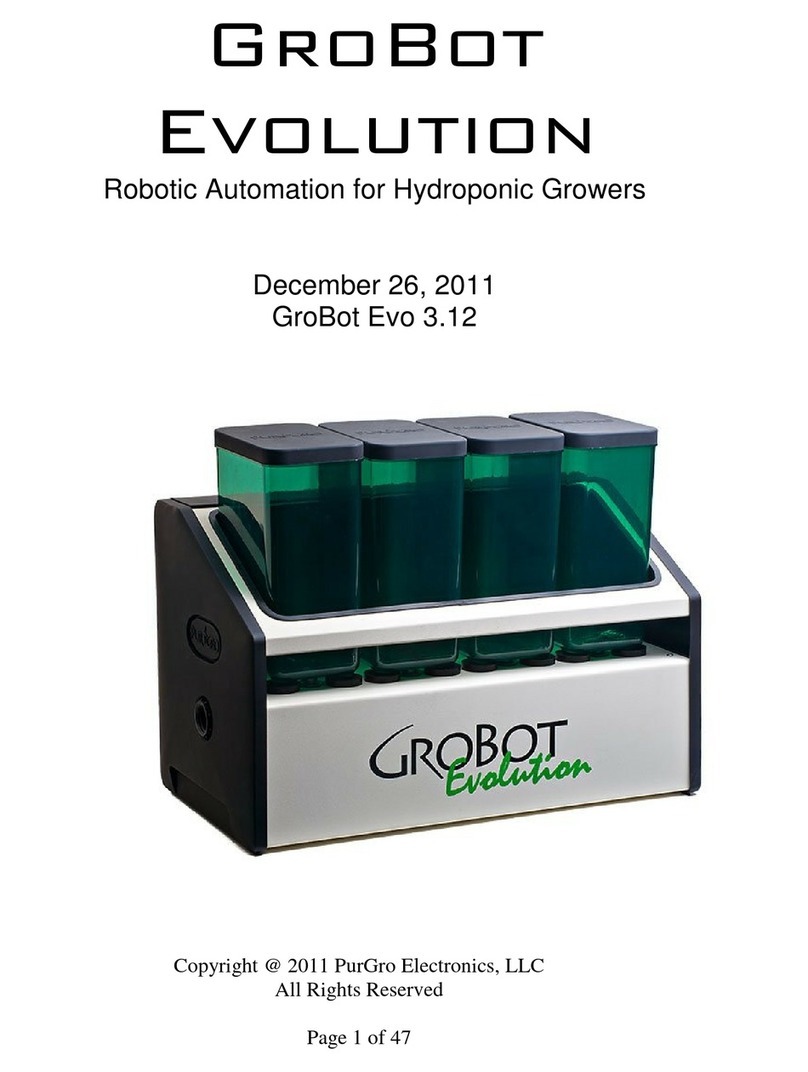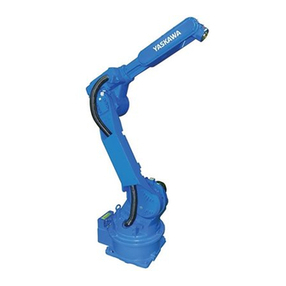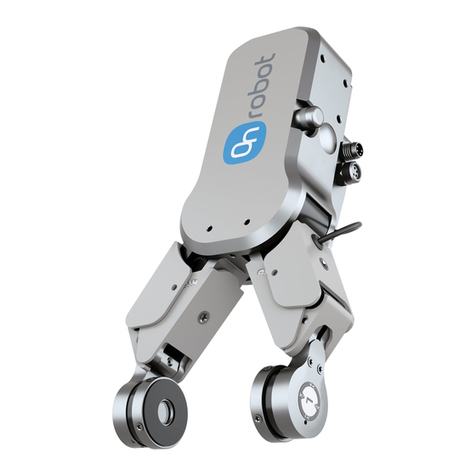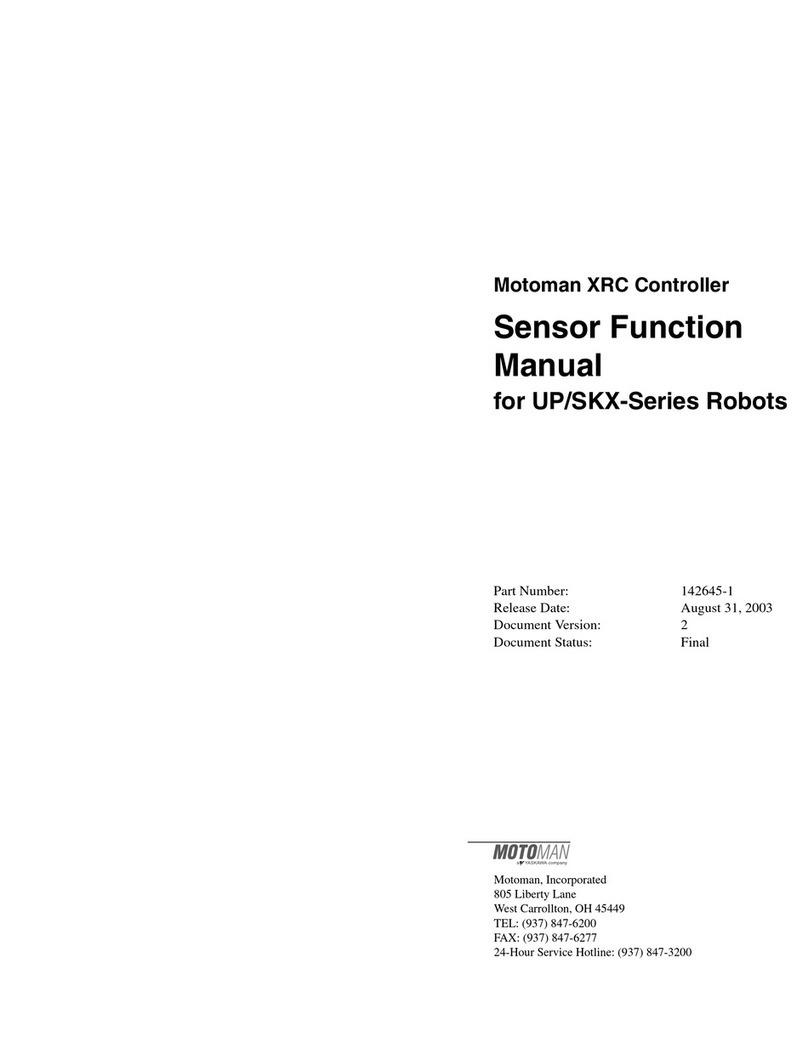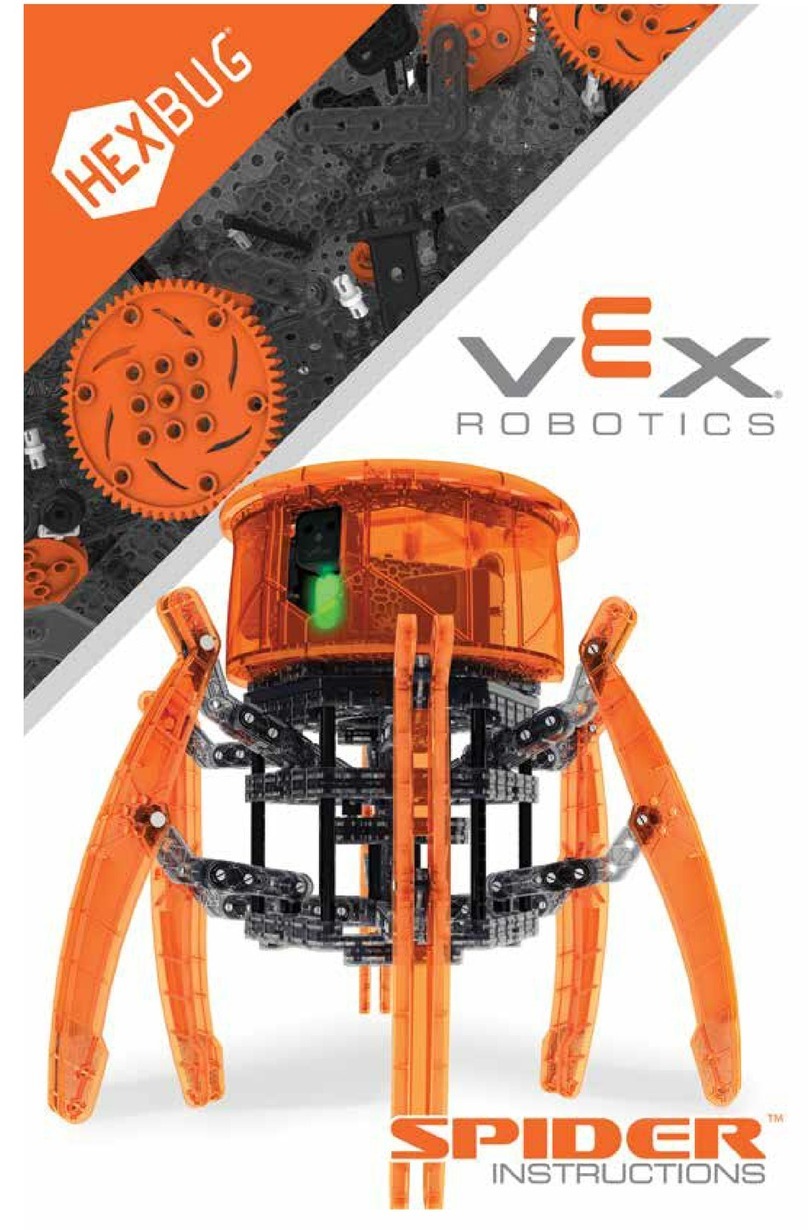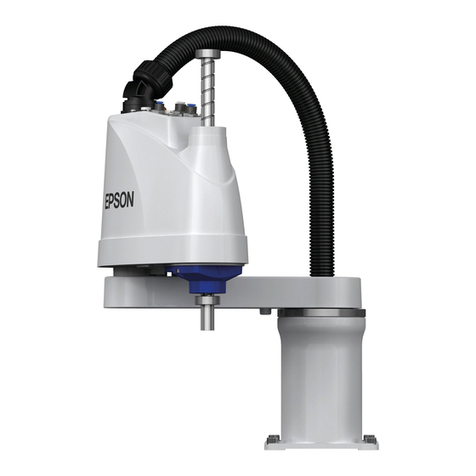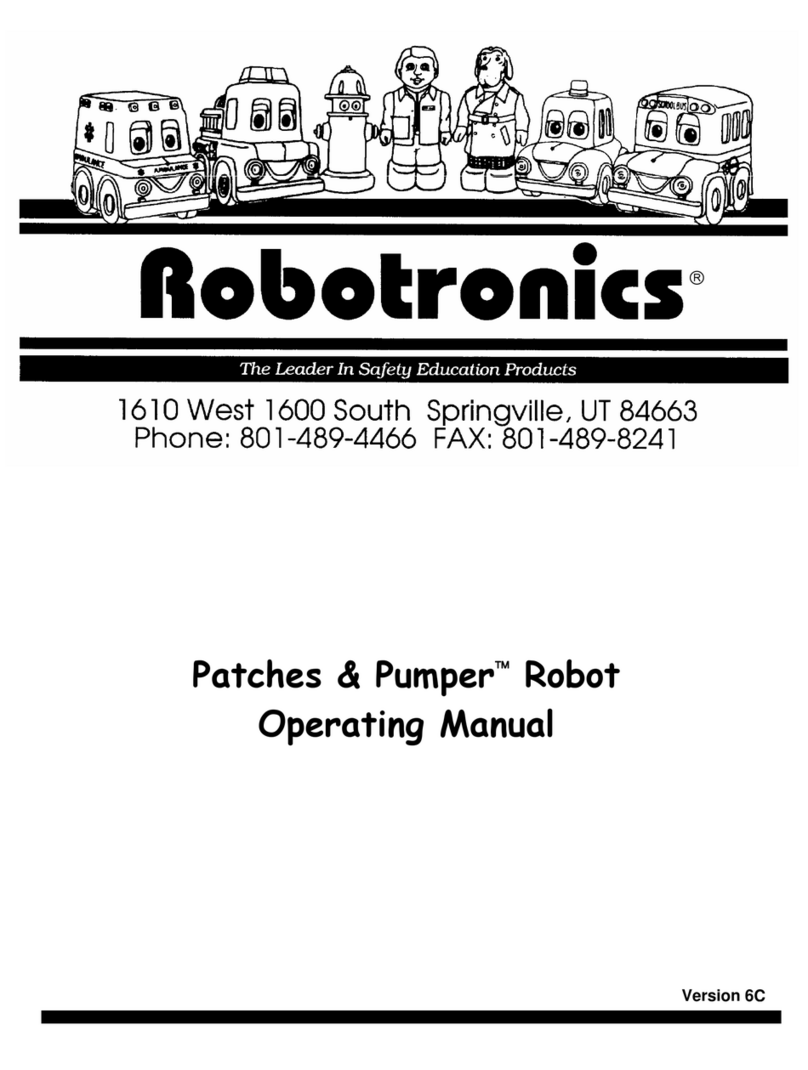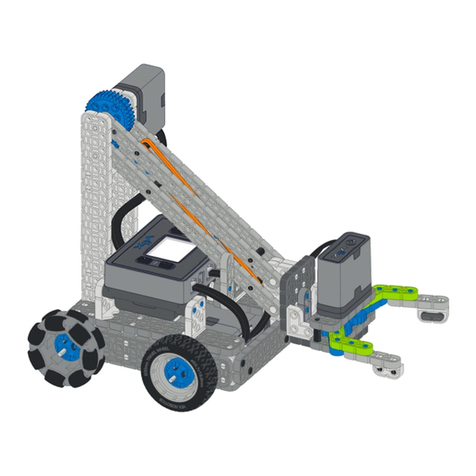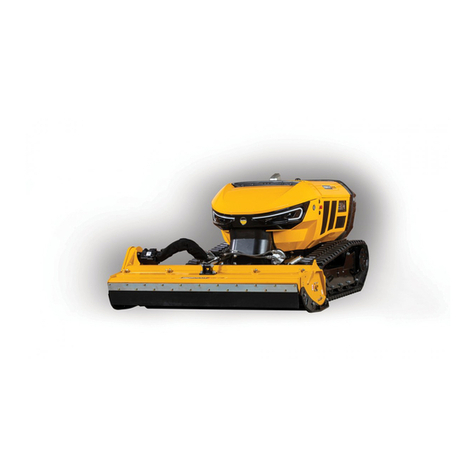Novanta ATI QC-11HM User manual

Manual, Hollow‑Wrist Robotic Tool Changer, QC‑11HM through QC‑27HM
Document #9610‑20‑2253‑12
Pinnacle Park • 1031 Goodworth Drive •Apex, NC 27539 • Tel: +1-919.772.0115 • Fax: +1-919.772.8259 • www.ati‑ia.com
2
Foreword
This manual contains basic information applicable to all ATI robotic Tool Changers. Certain models have their own
manuals that contain more detailed information. Also, additional information about electrical, pneumatic, fluid,
high‑power and high‑current modules and other options is available in other manuals and documents.
Please contact ATI Industrial Automation with any questions concerning your particular model.
CAUTION: This manual describes the function, application, and safety considerations of this
product. This manual must be read and understood before any attempt is made to install or
operate the product, otherwise damage to the product or unsafe conditions may occur.
Information contained in this document is the property of ATI Industrial Automation, Inc (ATI) and shall not be
reproduced in whole or in part without prior written approval of ATI. The information herein is subject to change without
notice. This manual is periodically revised to reflect and incorporate changes made to the product.
The information contained herein is confidential and reserved exclusively for the customers and authorized agents of ATI
Industrial Automation and may not be divulged to any third party without prior written consent from ATI. No warranty
including implied warranties is made with regard to accuracy of this document or fitness of this device for a particular
application. ATI Industrial Automation shall not be liable for any errors contained in this document or for any incidental
or consequential damages caused thereby. ATI Industrial Automation also reserves the right to make changes to this
manual at any time without prior notice.
ATI assumes no responsibility for any errors or omissions in this document.
Copyright © (2022) by ATI Industrial Automation. All rights reserved.
Contact Information:
Sale, Service and Information about ATI products:
ATI Industrial Automation
1031 Goodworth Drive
Apex, NC 27539 USA
www.ati‑ia.com
Tel: +1‑919.772.0115
Fax: +1‑919.772.8259
Application Engineering
Tel: +1‑919.772.0115
Fax: +1‑919.772.8259
E‑mail: [email protected]
24/7 Support: +1 855 ATI‑IA 00 (+1 855‑284‑4200)

Manual, Hollow‑Wrist Robotic Tool Changer, QC‑11HM through QC‑27HM
Document #9610‑20‑2253‑12
Pinnacle Park • 1031 Goodworth Drive •Apex, NC 27539 • Tel: +1-919.772.0115 • Fax: +1-919.772.8259 • www.ati‑ia.com
3
Table of Contents
1. Safety......................................................................................................................................... 7
1.1 Explanation of Notifications.........................................................................................................7
1.2 General Safety Guidelines............................................................................................................7
1.3 Safety Precautions........................................................................................................................8
2. Product Overview..................................................................................................................... 9
2.1 Hollow‑Wrist Master Plate Assembly ........................................................................................10
2.2 Tool Plate Assembly.................................................................................................................... 11
2.3 Master Plate/Tool Plate Coupling Mechanism.......................................................................... 11
2.4 Optional Modules........................................................................................................................12
3. Installation .............................................................................................................................. 12
3.1 Master Plate Installation.............................................................................................................14
3.2 Master Plate Removal.................................................................................................................15
3.3 Tool Interface Plate .....................................................................................................................16
3.4 Tool Plate Installation .................................................................................................................17
3.5 Tool Plate Removal .....................................................................................................................17
3.6 Optional Module Installation......................................................................................................18
3.6.1 QC‑11HM Simple Electrical Module Installation...............................................................18
3.6.2 QC‑11HM Simple Electrical Module Removal..................................................................18
3.6.3 QC‑11HM Master Electrical Module Installation...............................................................19
3.6.4 QC‑11HM Master Electrical Module Removal..................................................................19
3.6.5 QC‑11 Tool Electrical Module Installation.........................................................................20
3.6.6 QC‑11 Tool Electrical Module Removal............................................................................20
3.6.7 QC‑20HM, QC‑21HM, and QC‑27HM Flat A Optional K Series Module Installation........21
3.6.8 QC‑20HM, QC‑21HM, and QC‑27HM Flat A Optional K Series Module Removal...........21
3.6.9 QC‑21HM Flat B Optional Module Installation .................................................................22
3.6.10 QC‑21HM Flat B Optional Module Removal ....................................................................22
3.7 Lock and Unlock Pneumatic Requirements .............................................................................23
3.7.1 Valve Requirements and Connections.............................................................................23
3.8 Electrical Connections................................................................................................................25
3.8.1 PNP Type Lock and Unlock Sensors................................................................................25
3.8.2 NPN Type Lock and Unlock Sensors...............................................................................25
4. Operation ................................................................................................................................ 26
4.1 Coupling Sequence.....................................................................................................................27
4.2 Fail‑Safe Operation .....................................................................................................................27
4.3 Uncoupling Sequence.................................................................................................................28
4.4 Tool Identification........................................................................................................................28

Manual, Hollow‑Wrist Robotic Tool Changer, QC‑11HM through QC‑27HM
Document #9610‑20‑2253‑12
Pinnacle Park • 1031 Goodworth Drive •Apex, NC 27539 • Tel: +1-919.772.0115 • Fax:+1- 919.772.8259 • www.ati‑ia.com
4
4.5 Tool Storage Considerations .....................................................................................................29
5. Maintenance............................................................................................................................ 30
5.1 Preventive Maintenance .............................................................................................................31
5.2 Cleaning and Lubrication of the Locking Mechanism and Alignment Pins...........................32
5.3 Optional Electrical Module Pin Block Inspection and Cleaning.............................................34
6. Troubleshooting and Service Procedures ........................................................................... 35
6.1 Troubleshooting..........................................................................................................................35
6.2 Service Procedures.....................................................................................................................36
6.2.1 QC‑27HM Alignment Pin Replacement............................................................................36
6.2.2 Rubber Bushing Inspection and Replacement.................................................................37
6.2.3 Optional Electrical Module Seal Inspection and Replacement.........................................38
6.2.4 QC‑11HM Lock and Unlock Sensor Adjustment, Test, or Replacement...........................38
6.2.5 QC‑20HM and QC‑21HM Lock and Unlock Sensor Adjustment, Test, or Replacement ..40
6.2.6 QC‑27HM Lock and Unlock Sensor Adjustment, Test, or Replacement ..........................41
7. Specifications......................................................................................................................... 43
8. Serviceable Parts ................................................................................................................... 44
8.1 Models QC‑11HM Hollow‑Wrist Serviceable Parts...................................................................44
8.2 Models QC‑20HM Hollow‑Wrist Serviceable Parts...................................................................45
8.3 Models QC‑21HM Hollow‑Wrist Serviceable Parts...................................................................46
8.4 Models QC‑27HM Hollow‑Wrist Serviceable Parts...................................................................47
9. Drawings ................................................................................................................................. 48
9.1 QC‑11HM Hollow‑Wrist Tool Changer........................................................................................48
9.2 QC‑20HM Hollow‑Wrist Tool Changer .......................................................................................52
9.3 QC‑21HM Hollow‑Wrist Tool Changer .......................................................................................56
9.4 QC‑27HM Hollow‑Wrist Tool Changer .......................................................................................60
9.5 QC‑27HM Hollow‑Wrist Tool Changer with KM14 Module.......................................................63
10. Terms and Conditions of Sale............................................................................................... 65

Manual, Hollow‑Wrist Robotic Tool Changer, QC‑11HM through QC‑27HM
Document #9610‑20‑2253‑12
Pinnacle Park • 1031 Goodworth Drive •Apex, NC 27539 • Tel: +1-919.772.0115 • Fax: +1-919.772.8259 • www.ati‑ia.com
5
Glossary
Term Denition
Bearing Race A steel ring in the Tool plate that is engaged by the locking balls during the
coupling of the Tool Changer or Utility Coupler.
Cam A multi tapered sliding cylinder attached to the piston that forces the locking balls
outward during the locking process.
Coupling The physical action of the locking the Master and Tool plates together. See Lock
Detection Shaft Threaded stem inserted into the robot side of the piston, functions as a target to
actuate the lock and unlock sensors.
EIP End‑effector Interface Plate – interface plate between the Tool plate and
the customer’s end‑effector (tooling). Allows customized mounting to the
end‑effector.
Electrical Module Any of a wide variety of utility modules that pass electrical power and signals
through the Master and Tool modules to the end‑effector.
End‑Effector Tool used by the robot to perform a particular operation or function.
Fluid Module Any of a wide variety of utility modules that pass uids through the Master and
Tool modules to the end‑effector.
High Current Module Any of a wide variety of utility modules that pass electrical power through the
Master and Tool modules to the end‑effector.
Interface Plate (IP) Optional customized component used to adapt a Tool Changer or Utility Coupler
to the user’s robot or tooling.
Lock and Unlock Lock and Unlock sensing capability enables the customer to determine the state
of the master assembly locking mechanism.
Lock Port Pneumatic port on the Master plate through which air pressure is supplied to
Lock the Master plate to the Tool plate.
Lock Sensor A proximity sensor that detects the position of the pneumatically actuated piston
when it is in the locked or missed tool position.
Locked An output signal provided by a proximity sensor, indicating that the coupling
mechanism is in the Locked position.
Locking Balls Hardened steel ball bearings used in the fail‑safe locking mechanism. The
locking balls are forced outward by the cam against the bearing race to pull the
Master and Tool plates together.
Locking Mechanism
Manual, pneumatic or electrical driven device that draws the Master and Tool
plates together securing them in a fail‑safe locked condition until the mechanism
is unlocked. The locking mechanism consists of locking balls, cam, ball cage,
bearing race, and either an lever, pneumatic cylinder or an electric motor.
Lock The lock air pressure provided to the Master plate locking mechanism forcing the
cam to press the locking balls against the bearing race. This locks the Master
and Tool plates together.
Master plate The half of the Tool Changer that is mounted to a robot. The Master plate
contains the locking mechanism.
Moment The applied force multiplied by the distance it is from a point.
No‑Touch™ Design feature of all ATI Tool Changer products that allows coupling the Master
plate and Tool plate without physical contact prior to locking.
Piston Cylinder located in the Master plate that actuates the locking mechanism.
Pneumatic Module Any of a wide variety of utility modules that pass air or vacuum through the
Master and Tool modules to the end‑effector.

Manual, Hollow‑Wrist Robotic Tool Changer, QC‑11HM through QC‑27HM
Document #9610‑20‑2253‑12
Pinnacle Park • 1031 Goodworth Drive •Apex, NC 27539 • Tel: +1-919.772.0115 • Fax: +1-919.772.8259 • www.ati‑ia.com
6
Term Denition
Sensor Plate Cover plate for the back side of the Master plate, seals the pneumatic chamber
and provides mounting points for the Lock and Unlock switches.
Servo Module Any of a wide variety of utility modules that pass electrical power and servo
signals through the Master and Tool modules to the end‑effector equipped with a
servo motor.
SIP Sensor Interface Plate used to adapt the Tool Changer Master to the
customer‑supplied robot. The SIP contains sensors that determine the state
(Locked/Unlocked/No Tool) of the Master plate.
Tool plate The half of the Tool Changer to which various tools or end‑effectors are mounted.
Tool Stand Stand that holds Tools not being used by the robot.
Trip Dog A physical device used to activate a mechanical switch, use in the tool stand
Interlock circuit.
Uncoupling The physical action of the unlocking the Master and Tool plates. See Unlock .
Unlatch The output supplied to the ATI Master module to uncouple the Tool Changer.
Unlock Port Pneumatic port on the Master plate through which air pressure is supplied to
Unlock the Master plate from the Tool plate.
Unlock Sensor A proximity sensor that detects the position of the pneumatically actuated piston
when it is in the unlocked position.
Unlocked An output signal provided by a proximity sensor, indicating that the coupling
mechanism is in the Unlocked position.
Unlock The unlock air pressure provided to the Master plate locking mechanism forcing
the cam to release the locking balls from the bearing race. Allowing the Master
and Tool plates to be separated.

Manual, Hollow‑Wrist Robotic Tool Changer, QC‑11HM through QC‑27HM
Document #9610‑20‑2253‑12
Pinnacle Park • 1031 Goodworth Drive •Apex, NC 27539 • Tel: +1-919.772.0115 • Fax: +1-919.772.8259 • www.ati‑ia.com
7
1. Safety
The safety section describes general safety guidelines to be followed with this product, explanations of the
notifications found in this manual, and safety precautions that apply to the product. Product specific notifications
are imbedded within the sections of this manual (where they apply).
1.1 Explanation of Notifications
These notications are used in all of ATI manuals and are not specic to this product. The user should heed
all notications from the robot manufacturer and/or the manufacturers of other components used in the
installation.
DANGER: Notification of information or instructions that if not followed will result in
death or serious injury. The notification provides information about the nature of the
hazardous situation, the consequences of not avoiding the hazard, and the method for
avoiding the situation.
WARNING: Notification of information or instructions that if not followed could result
in death or serious injury. The notification provides information about the nature of the
hazardous situation, the consequences of not avoiding the hazard, and the method for
avoiding the situation.
CAUTION: Notification of information or instructions that if not followed could result
in moderate injury or will cause damage to equipment. The notification provides
information about the nature of the hazardous situation, the consequences of not
avoiding the hazard, and the method for avoiding the situation.
NOTICE: Notification of specific information or instructions about maintaining, operating,
installing, or setting up the product that if not followed could result in damage to equipment. The
notification can emphasize, but is not limited to: specific grease types, best operating practices,
and maintenance tips.
1.2 General Safety Guidelines
Prior to purchase and installation, the customer should verify that the Tool Changer selected is rated for the
maximum loads and moments expected during operation. Particular attention should be paid to dynamic
loads caused by robot acceleration and deceleration. These forces can be (exponentially) greater than the
value of static forces in high acceleration or deceleration situations. To verify an ATI product is rated for a
particular application, refer to the product specifications section and/or drawing section for each component
in this manual or contact ATI for assistance.
The customer is responsible for ensuring that the area between the Master and Tool sides is clear of foreign
objects during mating and subsequent coupling. Failure to do so may result in serious injury to personnel.
DANGER: The gap between the Master and Tool sides is a pinch point. All personnel
should abstain from placing any part of their body or clothing in the gap, especially
during actuation of the locking mechanism.
The customer is responsible for understanding the function of the Tool Changer and implementing the
proper fasteners and/or software to operate the Tool Changer safely. The Tool Changer should be controlled
such that there is no chance of locking or unlocking in a position that would endanger personnel and/or
equipment. If Lock/Unlock (L/U) and Ready‑to‑Lock (RTL) sensing capability are used, monitor the status
and apply interlocks to prevent injury and damage to personnel and equipment.
All pneumatic fittings and tubing must be capable of withstanding the repetitive motions of the application
without failing. The routing of electrical and pneumatic lines must minimize the possibility of stress/strain,
kinking, rupture, etc. Functional failure of electrical, pneumatic, or fluid lines may result in injury and
damage to personnel and equipment.
All electrical power, pneumatic and fluid circuits should be disconnected during servicing.

Manual, Hollow‑Wrist Robotic Tool Changer, QC‑11HM through QC‑27HM
Document #9610‑20‑2253‑12
Pinnacle Park • 1031 Goodworth Drive •Apex, NC 27539 • Tel: +1-919.772.0115 • Fax: +1-919.772.8259 • www.ati‑ia.com
8
1.3 Safety Precautions
WARNING: Remove all temporary protective materials (caps, plugs, tape, etc.) on
locking face of Tool Changer and modules prior to operation. Failure to do so will
result in damage to Tool Changers, modules, and end‑of‑arm tooling and could cause
injury to personnel.
WARNING: Do not perform maintenance or repair(s) on the Tool Changer or modules
unless the Tool is safely supported or placed in the tool stand, all energized circuits
(for example: electrical, air, water, etc.) are turned off, pressurized connections
are purged and power is discharged from circuits in accordance with the customer
safety practices and policies. Injury or equipment damage can occur with the Tool
not placed and energized circuits on. Place the Tool in the tool stand, turn off and
discharge all energized circuits, purge all pressurized connections, and verify all
circuits are de‑energized before performing maintenance or repair(s) on the Tool
Changer or modules.
WARNING: During operation, the area between the Master and Tool must be kept
clear. Failure to keep area clear will result in damage to Tool Changer, modules, or
end‑of‑arm tooling and could cause injury to personnel.
WARNING: The Tool Changer is only to be used for intended applications and
applications approved by the manufacturer. Using the Tool Changer in applications
other than intended will result in damage to Tool Changer, modules, or end‑of‑arm
tooling and could cause injury to personnel.
CAUTION: The Master plate locking mechanism must not be actuated without being
mounted to the interface plate. Damage to the Cover Plate and O‑ring may result.
Always attach the Master plate to the Interface plate prior to attempting any operations.

Manual, Hollow‑Wrist Robotic Tool Changer, QC‑11HM through QC‑27HM
Document #9610‑20‑2253‑12
Pinnacle Park • 1031 Goodworth Drive •Apex, NC 27539 • Tel: +1-919.772.0115 • Fax: +1-919.772.8259 • www.ati‑ia.com
9
2. Product Overview
ATI Tool Changers enhance the capability of a robot by enabling the use of multiple customer tools, such as
grippers, vacuum cup tooling, pneumatic and electric motors, weld guns, and more.
The Tool Changer consists of a Master plate, which is attached to the robot arm, and a Tool plate, which is attached
to customer tooling. When the robot is ready to pick up an end‑effector, the two plates lock together using a
patented, multi‑tapered cam with ball locking technology and a patented fail‑safe mechanism.
Ports in the body of the Tool Changer and optional modules can pass electrical signals and provide pneumatic or
fluid connections to customer tooling. See the respective manuals for these modules for more information.
Hollow‑Wrist Tool Changers enable internal routing of cables and air lines in hollow‑wrist robots. The axial air
ports pass directly into the Hollow‑Wrist robot, allowing the dress package to be protected and increase reliability.
These Tool Changers feature push‑to‑connect fittings and couple with standard Tool side Tool Changers. The ATI
Tool Changer has been designed to provide long life with minimal maintenance. Refer to Table 2.1 for different
Hollow‑Wrist models and their respective features.
Table 2.1—Hollow‑Wrist Models and Features
Model Payload Flats Plate Pneumatic Ports Part No. Sensor
QC‑11HM 35 lbs (1) Flat Master
(6) 1/8" tube ttings Pass‑through
(2) 1/8” tube ttings Lock/Unlock air
9120‑011HM‑000‑000‑S0 None
9120‑011HM‑000‑000‑SQ PNP
9120‑011HM‑000‑000‑SQN NPN
(6) 4 mm tube ttings Pass‑through
(2) 4 mm tube ttings Lock/Unlock air
9120‑011HM‑000‑000‑S0‑E None
9120‑011HM‑000‑000‑SQ‑E
9120‑011HM‑000‑000‑SQ‑M PNP
9120‑011HM‑000‑000‑SQN‑E NPN
Tool (6) M5 X 0.8 Pass‑through Ports 9120‑011T‑000‑000 N/A
QC‑20HM 55 lbs (1) Flat (K series
modules)
Master
(12) 1/8" tube ttings Pass‑through
(2) 1/8” tube ttings Lock/Unlock air
9120‑020HM‑000‑PM5‑SQ PNP
9120‑020HM‑000‑PM5‑SQN NPN
9120‑020HM‑000‑PM5‑S0 None
(12) 4 mm tube ttings Pass‑through
(2) 4 mm tube ttings Lock/Unlock air
9120‑020HM‑000‑PM5‑SQ‑E
9120‑020HM‑000‑PM5‑SQ‑M PNP
Tool (12) M5 X 0.8 Pass‑through Ports 9120‑020T‑000‑PM5
9120‑020T‑000‑PM5‑B N/A
QC‑21HM 55 lbs
(2) Flats ‑ (1)
Flat for K series
modules and
(1) Flat for J16
mounting pattern
(with adapter plate)
Master
(6) 1/8" tube ttings Pass‑through
(2) 1/4" tube ttings Pass‑through
(2) 1/8” tube ttings Lock/Unlock air
9120‑021HM‑000‑000‑SQ PNP
9120‑021HM‑000‑000‑S0 None
(6) 4 mm tube ttings Pass‑through
(2) 6 mm tube ttings Pass‑through
(2) 4 mm tube ttings Lock/Unlock air
9120‑021HM‑000‑000‑SQ‑E
9120‑021HM‑000‑000‑SQ‑M PNP
9120‑021HM‑000‑000‑S0‑E None
Tool (8) 1/8 NPT Pass‑through Ports 9120‑021T‑000‑000 N/A(8) 1/8‑28 BSPP Pass‑through Ports 9120‑021T‑000‑000‑E
(8) 1/8‑28 BSPT(R) Pass‑through Ports 9120‑021T‑000‑000‑R
QC‑27HM 83 lbs (1) Flat for K series
modules Master (8) 4 mm tube ttings Pass‑through
(2) 4 mm tube ttings Lock/Unlock air
9120‑027HM‑000‑000‑S0‑E
9120‑027HM‑000‑000‑S01‑E None
9120‑027HM‑000‑000‑SQ‑E
9120‑027HM‑000‑000‑SQ1‑E PNP
Tool (8) 1/8‑28 BSPP Pass‑through Ports 9120‑027T‑000‑000‑E N/A
Notes:
1. Hollow‑Wrist Master Plate Assemblies with (‑E) part numbers have black anodized bodies all other have orange anodized
bodies.
2. Hollow‑Wrist Tool plate Assemblies with (‑B or ‑E) part numbers have black anodized bodies
3. Hollow‑Wrist Master Plate Assemblies with (‑SQ1) part numbers have sensor with flying leads.

Manual, Hollow‑Wrist Robotic Tool Changer, QC‑11HM through QC‑27HM
Document #9610‑20‑2253‑12
Pinnacle Park • 1031 Goodworth Drive •Apex, NC 27539 • Tel: +1-919.772.0115 • Fax: +1-919.772.8259 • www.ati‑ia.com
10
ATool Changer enhances the flexibility and reliability of a robotic cell. Robotic Tool Changers are used in
automated Tool change applications, as well as manual Tool change operations. Robotic Tool Changers also provide
a method for quick Tool change for maintenance purposes.
2.1 Hollow‑Wrist Master Plate Assembly
The Master plate assembly includes an anodized aluminum body, a hardened stainless‑steel locking
mechanism, and hardened steel alignment pins. The locking mechanism consists of a cam, a male coupling,
and chrome‑steel ball bearings. The Master plate provides one or two flat sides for mounting optional
modules, depending on the model and application.
Figure 2.1—Hollow‑Wrist Master Plate Assemblies
Adapter Plate
(Sold Separatly)
Optional Module Flat
Optional Lock and
Unlock Sensor
Locating Dowel
Mounting Pattern
Lock, Unlock, and
Pass Through Air Port
Adapter Plate
(Sold Separatly)
(2) 1/4" Pass Through Air Port
Lock, Unlock, and
Pass Through Air Port
Mounting Pattern
Locating Dowel
Master Plate Assembly
(QC-11HM Shown)
(2) Alignment Bushing
Male Coupling
Ball Bearing
Pass Through
Air Port
Master Plate Assembly
(QC-21HM Shown)
(2) Tapered Alignment Pin
Pass Through Air Port
Ball Bearing
Male Coupling
Optional Lock and
Unlock Sensor
The Master plate is equipped with axial air ports that pass directly into the hollow‑wrist robot, increasing
reliability. The air ports provide lock and unlock air for the locking mechanism and pass‑through air for the
end of arm tooling. A separate adapter plate assembly provides a standoff for the air ports and a mounting
pattern to attach to the robot arm. Adapter plates are available from ATI.
Alignment pins mate with bushings to ensure repeatable alignment during the coupling process. An extreme
pressure grease is applied to the cam, male coupling, ball bearings, and pins to enhance performance and
maximize the life of the Master plate assembly. Refer to Section 5.2—Cleaning and Lubrication of the
Locking Mechanism and Alignment Pins for lubrication instructions. In some models, the Master plate is
equipped with tapered alignment pins. Other models, such as the QC‑11HM Hollow‑Wrist Master plate,
have hardened stainless steel alignment bushings.
Optional proximity sensors, located in the body of the Master plate, verify the lock and unlock position of
the piston and cam. The sensors provide lock and unlock signals. Refer to Section 2.3—Master Plate/Tool
Plate Coupling Mechanism for more information.

Manual, Hollow‑Wrist Robotic Tool Changer, QC‑11HM through QC‑27HM
Document #9610‑20‑2253‑12
Pinnacle Park • 1031 Goodworth Drive •Apex, NC 27539 • Tel: +1-919.772.0115 • Fax: +1-919.772.8259 • www.ati‑ia.com
11
2.2 Tool Plate Assembly
The Tool plate assembly includes an anodized aluminum body and a hardened stainless‑steel bearing race.
The Tool plate provides one or two flat sides for mounting of optional modules, depending on the model.
Optional modules can be arranged to suit the application. In some models, the bearing race or Tool plate
body has integrated alignment holes or bushings. Other models, such as the QC‑11HM Tool plate, have
hardened steel alignment pins.
The Tool plate is equipped with pass‑through air ports to supply air to customer tooling.
Figure 2.2—Tool Plate Assemblies
Optional Module Flat B
Optional Module Flat A
Optional Module Flat
Tool Plate Assembly
(QC-11 Shown)
Tool Plate Assembly (QC-21 Shown)
(2) Steel
Alignment Pin
Harden Stainless Steel
Bearing Race
Stainless Steel
Bearing Race
(2) Integrated
Alignment Hole
Pass-through Air Port
Pass-through
Air Port
2.3 Master Plate/Tool Plate Coupling Mechanism
Coupling the Master and Tool plate is achieved through a patented, stainless steel mechanism. During
locking, steel balls in the Master plate are driven outward by a circular cam attached to a pneumatically
actuated piston. The cam profile has three features: a lead‑in angle (conical), a flat (cylindrical) area, and a
secondary angle (conical). The lead‑in angle initiates the coupling process. The flat area on the cam assures
the coupling will not be compromised in case of air loss (fail‑safe feature). A secondary angle on the cam
provides rigid coupling during normal operation. The balls engage a bearing race (or “locking ring”) in the
Tool plate and lock the Master plate and Tool plate tightly together.
Figure 2.3—Master Plate Assemblies
Ball Bearings
Circular Cam
Piston
Ball Cage
Bearing Race
Unlock Sensor
Sensor Target

Manual, Hollow‑Wrist Robotic Tool Changer, QC‑11HM through QC‑27HM
Document #9610‑20‑2253‑12
Pinnacle Park • 1031 Goodworth Drive •Apex, NC 27539 • Tel: +1-919.772.0115 • Fax: +1-919.772.8259 • www.ati‑ia.com
12
2.4 Optional Modules
Hollow‑Wrist Tool Changers have one or two flats depending on the model. Optional modules support
the pass‑through of various utilities, such as signal, fluid/air, and power. Refer to Table 2.2 for more
information. Some modules require an adapter plate.
For assistance in choosing the right modules for your particular application, visit our website or contact an
ATI Sales Representative.
Table 2.2—Hollow‑Wrist Models and Features
Hollow‑Wrist
Model For the most current list, information, and specications for compatible
Optional Modules click the link below
QC‑11HM QC‑11 Hollow‑Wrist Web Page and select the Compatible modules tab
QC‑20HM QC‑20 Hollow‑Wrist Web Page and select the Compatible modules tab
QC‑21HM QC‑21 Hollow‑Wrist Web Page and select the Compatible modules tab
QC‑27HM QC‑27 Hollow‑Wrist Web Page and select the Compatible modules tab
Note: TheATI website provides information on the Standard compatible modules additional custom
modules are available, contact an ATI Sales Representative directly
3. Installation
All fasteners used to mount the Tool Changer to the robot and to customer tooling should be tightened to a torque
value as indicated. Fasteners should have pre‑applied adhesive or be applied with removable (blue) Loctite®as
specified in Table 3.1. Pneumatic lines and electrical cables are attached, bundled, and must be strain‑relieved in a
manner that allows for freedom of movement during operation.
WARNING: Do not perform maintenance or repair(s) on the Tool Changer or modules unless
the Tool is safely supported or placed in the tool stand, all energized circuits (for example:
electrical, air, water, etc.) are turned off, pressurized connections are purged and power
is discharged from circuits in accordance with the customer specific safety practices and
policies. Injury or equipment damage can occur with the Tool not placed and energized
circuits on. Place the Tool in the tool stand, turn off and discharge all energized circuits,
purge all pressurized connections, and verify all circuits are de‑energized before performing
maintenance or repair(s) on the Tool Changer or modules.
WARNING: All pneumatic fittings and tubing must be capable of withstanding the repetitive
motions of the application without failing. The routing of electrical and pneumatic lines must
minimize the possibility of over stressing, pullout, or kinking the lines. Failure to do so can
cause critical electrical and/or pneumatic lines to malfunction and might result in injury to
personnel or damage to equipment.

Manual, Hollow‑Wrist Robotic Tool Changer, QC‑11HM through QC‑27HM
Document #9610‑20‑2253‑12
Pinnacle Park • 1031 Goodworth Drive •Apex, NC 27539 • Tel: +1-919.772.0115 • Fax: +1-919.772.8259 • www.ati‑ia.com
13
WARNING: Do not use lock washers under the head of the mounting fasteners or allow the
mounting fasteners to protrude above the mating surfaces of the Master and Tool plates.
Allowing fasteners to protrude above the mating surface will create a gap between the Master
and Tool plates and not allow the locking mechanism to fully engage, this can cause damage
to equipment or personal injury. The mounting fasteners must be flush or below the mating
surfaces of the Master and Tool plates.
Head of Mounting Fastener Must Be Flush or
Below Mating Surface. (Do Not Use Lock
Washer under Head of Mounting Fastener.)
Mating Surface
CAUTION: Do not use fasteners that exceed the thread depth in the Tool Changer. Refer to
Section 9—Drawings for details on mounting hole thread depth. Secure the Tool Changer with
the proper length fasteners. This is true for both robot and tool interfaces.
CAUTION: Thread locker applied to fasteners must not be used more than once. Fasteners
might become loose and cause equipment damage. Always apply new thread locker when
reusing fasteners.
CAUTION: Failure to follow the tool interface plate design consideration in Section 3.3—Tool
Interface Plate may result in loosening of the interface during operation. Follow the guidelines
provided when designing an interface plate for the Tool Changer.
Table 3.1—Fastener Size, Class, and Torque Specications
Mounting Conditions Fastener Size,
Property Class, and
Type
Recommended
Torque Thread
Locker
QC‑11HM Master plate to adapter plate, Supplied Fasteners M3‑30 Class 12.9 10 in‑lbs (1.13 Nm)
Pre‑applied
Adhesive or
Loctite 222
QC‑20HM QC‑21HM and QC‑27HM Master plate to adapter
plate, Supplied Fasteners M4‑30 Class 12.9 17 in‑lbs (1.9 Nm)
Tool Interface Plate to QC‑11 Tool plate
Minimum thread engagement of 7.5 mm [1.5X fastener Ø].
Do not exceed maximum available thread depth of 8 mm as
shown in Section 9—Drawings
M5 x 0.8 Class 12.9 ‑
Socket head cap 45 in‑lbs (5.08 Nm)
Socket at head cap 35 in‑lbs (3.96 Nm)
Tool Interface Plate to QC‑20, QC‑21, and QC‑27 Tool plate
Minimum thread engagement of 9 mm [1.5X fastener Ø]. Do
not exceed maximum available thread depth of 10 mm as
shown in Section 9—Drawings
M6 x 1.0 Class 12.9 ‑ Pre‑applied
Adhesive or
Loctite 242
Socket head cap 90 in‑lbs (10.2 Nm)
Socket at head cap 60 in‑lbs (6.78 Nm)

Manual, Hollow‑Wrist Robotic Tool Changer, QC‑11HM through QC‑27HM
Document #9610‑20‑2253‑12
Pinnacle Park • 1031 Goodworth Drive •Apex, NC 27539 • Tel: +1-919.772.0115 • Fax: +1-919.772.8259 • www.ati‑ia.com
14
3.1 Master Plate Installation
The Master plate is mounted to the robot flange using an adapter plate with a robot mounting hole pattern
on one side and a Master plate mounting hole pattern on the other (consult the appropriate drawings for
dimensions, fastener, and dowel pin specifics).
Tools required: 2 mm and 2.5 mm hex key, torque wrench
Supplies required: Clean rag, Loctite 222
1. Place the Tool in a secure location.
2. Uncouple the Master and Tool plates.
3. Turn off and de‑energize all energized circuits; for example: electrical, air ,water, etc.
4. Wipe down the mounting surfaces with a clean rag.
5. Align the dowel pin in the adapter plate to the corresponding holes in the robot arm and secure with
supplied fasteners, refer to Figure 3.1. Refer to Table 3.1 for proper fasteners and torque.
6. Connect all Lock, Unlock, and pass‑through air connections through the robot wrist to the
connections on the Master plate. For lock and unlock air, refer to Section 3.7—Lock and Unlock
Pneumatic Requirements.
7. If equipped, connected the lock and unlock sensor cables through the robot wrist. Note: for the
QC‑11HM Hollow‑Wrist Tool Changer, the lock and unlock sensor cables are routed around the channel
in the adapter plate and secured using the (2) socket flat head cap screws, refer to Figure 3.1.
8. If equipped, connect other utilities to the optional modules on the Master plate.
9. Align the dowel pin in the adapter plate to the corresponding holes in the Master plate and secure with
supplied fasteners, refer to Figure 3.1. Refer to Table 3.1 for proper fasteners and torque.
10. Safely resume normal operation.

Manual, Hollow‑Wrist Robotic Tool Changer, QC‑11HM through QC‑27HM
Document #9610‑20‑2253‑12
Pinnacle Park • 1031 Goodworth Drive •Apex, NC 27539 • Tel: +1-919.772.0115 • Fax: +1-919.772.8259 • www.ati‑ia.com
15
Figure 3.1—Typical Master Plate Installation
Robot Arm
Adapter Plate
(9005-20-6160 Shown)
(Sold Separatly)
Master Plate Assembly
(QC-21HM Shown)
(6) M4 socket Head Cap Screw
(6) M4 Socket Head Cap Screw
Route Optional Lock /
Unlock Sensor Cables
Through Robot Wrist
(4) M3 Socket Head Cap Screw
Robot Arm
(8) M4 socket Head Cap Screw
Master Plate Assembly
(QC-11HM Shown)
Route Optional Lock / Unlock
Sensor Cables in Channel
and Through Robot Wrist
Cable Channel
Connect Lock / Unlock and
Pass Through Air Lines
Through Robot Wrist
Connect Lock / Unlock and
Pass Through Air Lines
Through Robot Wrist
Adapter Plate
(9005-20-1667 Shown)
(Sold Separatly)
3.2 Master Plate Removal
Refer to Figure 3.1 for Master module removal instructions.
Tools required: 2.5 mm hex key
1. Place the Tool in a secure location.
2. Uncouple the Master and Tool plates.
3. Turn off and de‑energize all energized circuits (for example: electrical, pneumatic, and
hydraulic circuits).
4. Remove the fasteners securing the Master plate to the adapter plate. Refer to Figure 3.1.
5. If equipped, disconnect all utilities (for example: electrical, pneumatic, and hydraulic).
6. If equipped, disconnect the lock and unlock sensor cables.
7. Disconnect the Lock, Unlock, and pass‑through air connections.
8. Remove the Master plate.

Manual, Hollow‑Wrist Robotic Tool Changer, QC‑11HM through QC‑27HM
Document #9610‑20‑2253‑12
Pinnacle Park • 1031 Goodworth Drive •Apex, NC 27539 • Tel: +1-919.772.0115 • Fax: +1-919.772.8259 • www.ati‑ia.com
16
3.3 Tool Interface Plate
The Tool plate is attached to the customer’s tooling. An interface plate can adapt the Tool plate to customer
tooling. Alignment features (dowel holes and a recess) accurately position and bolt holes to secure the Tool
plate to customer tooling. Custom interface plates can be supplied by ATI (refer to the application drawing).
CAUTION: Do not use more than two alignment features when securing a Tool plate
to an interface plate. Using more than two alignment features can cause damage to
equipment. Use either two dowel pins or a single dowel pin, along with a boss/recess
feature to align the Tool plate with the interface plate.
CAUTION: Do not use dowel pins that are too long or do not allow the interface plate
and Tool body to mate flush. Using dowel pins that are too long will cause a gap
between the interface plate and Tool body and damage the equipment. Use dowel pins
that will not extend further than allowed by the Tool body.
Tool Plate
Interface Plate
Dowel pins are
proper size allowing
interface plate and Tool
Plate to mount flush.
Two dowel pins (or a
boss/recess) used as
alignment features.
Correct Mounting of Tool Plate
Tool Plate
Interface Plate
Dowel pins
are too long and
cause a gap between
interface plate and Tool.
Boss and two dowel pins
as alignment features can be
difficult to align and can
damage equipment.
Gap
Incorrect Mounting of Tool Plate
single dowel pin along with a
If the customer chooses to design and build a tool interface plate, consider the following points:
• The interface plate should include bolt holes for mounting and either two dowel pins or a dowel
pin and a boss for accurate positioning on the customer tooling and Tool plate. The dowel and boss
features prevent unwanted rotation.
• Dowel pins must not extend out from the surface of the interface plate farther than the depth of the
dowel holes in the Tool plate.
• The thickness of the interface plate must be sufficient to provide the necessary thread engagement
for the mounting bolts. Fasteners should meet minimum recommended engagement lengths while not
exceeding the maximum available thread depth. Use of bolts that are too long can cause damage to the
tool side changer.
• The plate design must account for clearances required for Tool Changer module attachments
and accessories.
• If a boss is to be used on the interface plate, a boss of proper height and diameter must be machined
into the interface plate to correspond with the recess in the Tool plate.
• The interface plate must have a hole in its center for manually returning the locking mechanism to the
unlocked position under adverse conditions (i.e. unintended loss of power and/or air pressure). The
center access hole with a minimum diameter of 1” (25.4 mm) prevents debris from contaminating the
locking mechanism. Greater protection is provided by leaving the race cover and grommet in place.

Manual, Hollow‑Wrist Robotic Tool Changer, QC‑11HM through QC‑27HM
Document #9610‑20‑2253‑12
Pinnacle Park • 1031 Goodworth Drive •Apex, NC 27539 • Tel: +1-919.772.0115 • Fax: +1-919.772.8259 • www.ati‑ia.com
17
3.4 Tool Plate Installation
The end‑effector is typically attached to the Tool plate with an interface plate designed refer to Section 3.3—
Tool Interface Plate for specific requirements.
Tools required: 5 mm, 4 mm, or 3 mm hex key, torque wrench
Supplies required: Clean rag, Loctite 222 or 242
1. Place the Tool in a secure location.
2. Uncouple the Master and Tool plates.
3. Turn off and de‑energize all energized circuits; for example: electrical, air ,water, etc.
4. Wipe down the mounting surfaces with a clean rag.
5. Align the dowel pins in the tool interface plate or customer tooling to the corresponding holes in the Tool
plate and secure with customer supplied mounting fasteners. Apply Loctite to threads or use fasteners
with pre‑applied adhesive, refer to Table 3.1 for proper thread engagement, torque and thread locker
(Note: Mounting fasteners are supplied with ATI custom tool interface plates.)
6. Connect utilities to the appropriate module and Tool plate connections.
7. Safely resume normal operation.
Figure 3.2—Typical Tool Plate Installation
(4) M6 Socket Head Cap Screw
Tool Interface Plate
Tool Plate Assembly
(QC-21 Shown)
Tool Interface Plate
(4) M5 Socket Head Cap Screw
Tool Plate Assembly
(QC-11 Shown)
(Customer Supplied) (Customer Supplied)
(Customer Supplied) (Customer Supplied)
3.5 Tool Plate Removal
Tools required: 5 mm, 4 mm, or 3 mm hex key
1. Place the Tool in a secure location.
2. Uncouple the Master and Tool plates.
3. Turn off and de‑energize all energized circuits; for example: electrical, air ,water, etc.
4. Disconnect all utilities (for example: electrical, pneumatic, and hydraulic).
5. Remove the fasteners securing the Tool plate to the tool interface Plate. Refer to Figure 3.2.
6. Remove the Tool plate.

Manual, Hollow‑Wrist Robotic Tool Changer, QC‑11HM through QC‑27HM
Document #9610‑20‑2253‑12
Pinnacle Park • 1031 Goodworth Drive •Apex, NC 27539 • Tel: +1-919.772.0115 • Fax: +1-919.772.8259 • www.ati‑ia.com
18
3.6 Optional Module Installation
The optional modules are typically installed on Tool Changers by ATI prior to shipment. Installation and
removal are outlined in the following section: Tool Changers are compatible with many different types of
modules. Some modules will require an adapter plate to be installed to the Tool Changer.
3.6.1 QC‑11HM Simple Electrical Module Installation
Tools required: 2.5 mm hex key, torque wrench
Supplies required: Clean rag, Loctite 222
1. Place the Tool in a secure location.
2. Uncouple the Master and Tool plates.
3. Turn off and de‑energize all energized circuits; for example: electrical, air ,water, etc.
4. Wipe down the mounting surfaces with a clean rag.
5. If the Tool Changer is in service, place the Tool safely in the tool stand and uncouple the Tool
Changer to allow clear access to the Master and Tool plates.
6. Make all soldered connections to the simple electrical module as desired.
7. Make sure mounting surfaces of the Tool plate, Master plate, and modules are clean and
free of debris.
8. Align the module to the flat of the Master or Tool plate assembly.
9. Apply Loctite 222 to M3 socket head cap screws.
10. Secure the module with (2) M3 socket head cap screws using a 2.5 mm hex key. Tighten to
24 in‑oz (0.17 Nm).
11. Remove all protective caps, plugs, tape, etc from the module prior to operation.
12. Safely resume normal operation.
Figure 3.3—QC‑11HM Simple Electrical Module Installation
(2) M3 Socket Head Cap Screw
Tool Plate Assembly
(QC-11 Shown)
Master Plate Assembly
(QC-11HM Hollow-Wrist Shown)
(2) M3 Socket Head Cap Screw
Electrical Module
(9120-E10M-010 Shown)
Electrical Module
(9120-E10T-010 Shown)
3.6.2 QC‑11HM Simple Electrical Module Removal
Tools required: 2.5 mm hex key
1. Place the Tool in a secure location.
2. Uncouple the Master and Tool plates.
3. Turn off and de‑energize all energized circuits; for example: electrical, air ,water, etc.
4. Disconnect any cables.
5. Remove the (2) M3 socket head cap screws using a 2.5 mm hex key.
6. Remove the module from the Master or Tool plate.

Manual, Hollow‑Wrist Robotic Tool Changer, QC‑11HM through QC‑27HM
Document #9610‑20‑2253‑12
Pinnacle Park • 1031 Goodworth Drive •Apex, NC 27539 • Tel: +1-919.772.0115 • Fax: +1-919.772.8259 • www.ati‑ia.com
19
3.6.3 QC‑11HM Master Electrical Module Installation
Tools required: 2.5 mm and 2 mm hex key, torque wrench
Supplies required: Clean rag, Loctite 222
1. Place the Tool in a secure location.
2. Uncouple the Master and Tool plates.
3. Turn off and de‑energize all energized circuits; for example: electrical, air ,water, etc.
4. Remove the (4) M3 socket head cap screws securing the cover to the module using
a 2 mm hex key.
5. Align the cover to the QC‑11HM Master plate.
6. Apply Loctite 222 to M3 socket head cap screws.
7. Secure the cover with (2) M3 socket head cap screws using a 2.5 mm hex key. Tighten to
48 in‑oz (0.34 Nm).
8. Apply Loctite 222 to the (4) M3 socket flat head cap screws.
9. Attach the module to the cover using the (2) long and (2) short M3 socket flat head cap screws
using a 2.5 mm hex key. Tighten to 48 in‑oz (0.34 Nm).
10. Remove all protective caps, plugs, tape, etc from the module prior to operation.
11. Safely resume normal operation.
Figure 3.4—QC‑11HM Master Electrical Module Installation
(2) M3 Socket Head Cap Screw
Master Plate Assembly
(QC-11HM Shown)
(2) M3 Socket Flat Head
Cap Screw (Long)
Electrical Module
(9120-A15-M Shown)
(2) M3 Socket Flat Head
Cap Screw (Short)
Cover
3.6.4 QC‑11HM Master Electrical Module Removal
Tools required: 2.5 mm and 2 mm hex key
1. Place the Tool in a secure location.
2. Uncouple the Master and Tool plates.
3. Turn off and de‑energize all energized circuits; for example: electrical, air ,water, etc.
4. Disconnect any cables.
5. Remove the (4) M3 socket flat head cap screws holding the module to the cover using a
2.5 mm hex key.
6. Remove the module from the cover.
7. Support the cover, while removing the (2) M3 socket head cap screws using a 2.5 mm hex key.
8. Remove the cover from the Master plate.

Manual, Hollow‑Wrist Robotic Tool Changer, QC‑11HM through QC‑27HM
Document #9610‑20‑2253‑12
Pinnacle Park • 1031 Goodworth Drive •Apex, NC 27539 • Tel: +1-919.772.0115 • Fax: +1-919.772.8259 • www.ati‑ia.com
20
3.6.5 QC‑11 Tool Electrical Module Installation
Tools required: 2.5 mm hex key, 3/16” wrench, torque wrench
Supplies required: Clean rag, Loctite 222
1. Place the Tool in a secure location.
2. Uncouple the Master and Tool plates.
3. Turn off and de‑energize all energized circuits; for example: electrical, air ,water, etc.
4. Wipe down the mounting surfaces with a clean rag.
5. Remove the (2) screw locks securing the connector to the module.
6. Carefully remove the connector to expose the mounting screws as shown in Figure 3.5.
7. Align the module to the QC‑11 Tool plate.
8. Apply Loctite 222 to M3 socket head cap screws.
9. Secure the module with (2) M3 socket head cap screws using a 2.5 mm hex key. Tighten to
24 in‑oz (0.17 Nm).
10. Apply Loctite 222 to the (2) screw locks.
11. Attach the connector to the module using the (2) screw locks using a 3/16” wrench. Tighten to
24 in‑oz (0.17 Nm).
12. Remove all protective caps, plugs, tape, etc from the module prior to operation.
13. Safely resume normal operation.
Figure 3.5—QC‑11 Tool Electrical Module Installation
(2) M3 Socket Head
Cap Screw
Tool Plate Assembly
(QC-11 Shown)
Connector
Electrical Module
(9120-A15-T Shown)
(2) Screw Lock
3.6.6 QC‑11 Tool Electrical Module Removal
Tools required: 2.5 mm hex key, 3/16” wrench
1. Place the Tool in a secure location.
2. Uncouple the Master and Tool plates.
3. Turn off and de‑energize all energized circuits; for example: electrical, air ,water, etc.
4. Disconnect any cables.
5. Remove the (2) screw locks securing the connector to the module using a 3/16” wrench.
6. Carefully remove the connector to expose the mounting screws as shown in Figure 3.5.
7. Remove the (2) M3 socket head cap screws holding the module to the QC‑11 Tool plate using a
2.5 mm hex key.
8. Remove the module from the Tool plate.
This manual suits for next models
3
Table of contents
Popular Robotics manuals by other brands
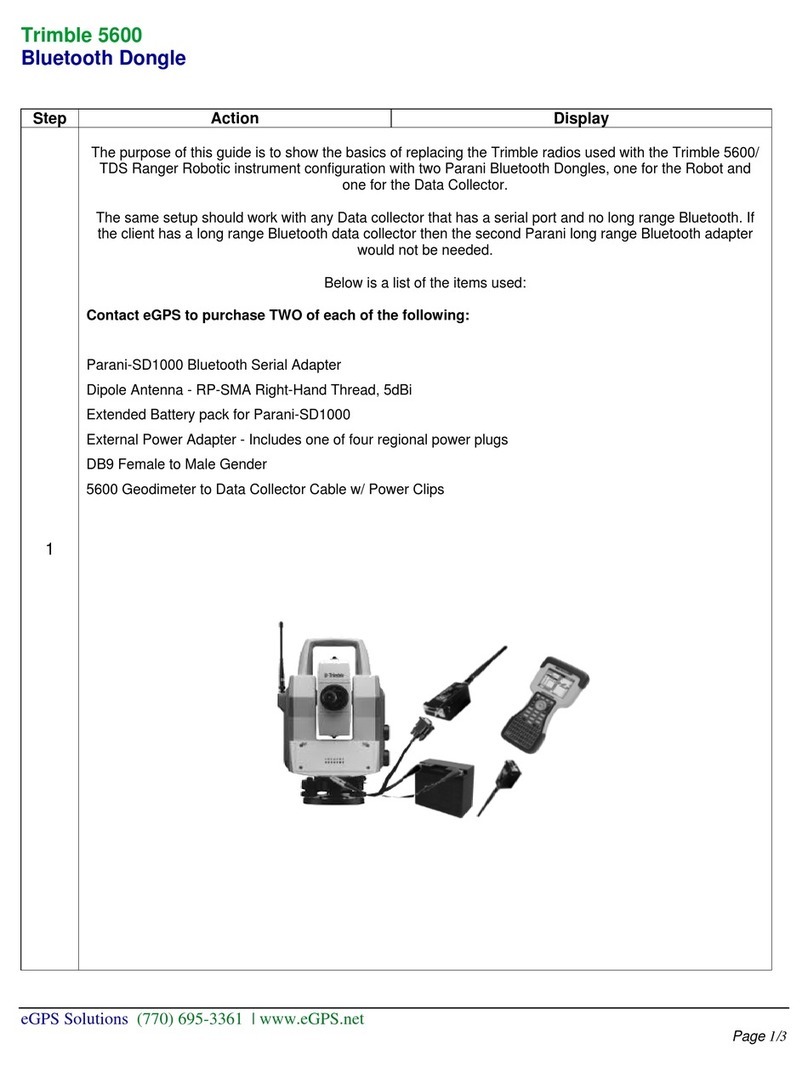
eGPS Solutions
eGPS Solutions Trimble 5600 quick start guide
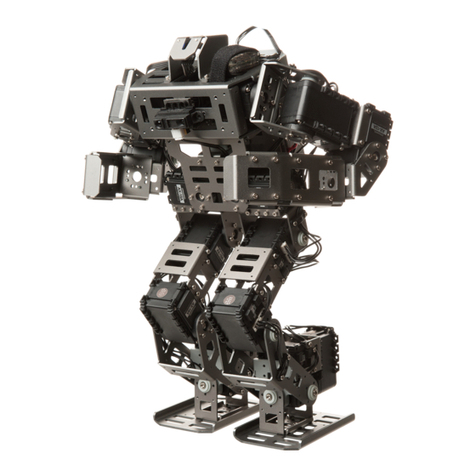
Robotis
Robotis BIOLOID GP Assembly manual
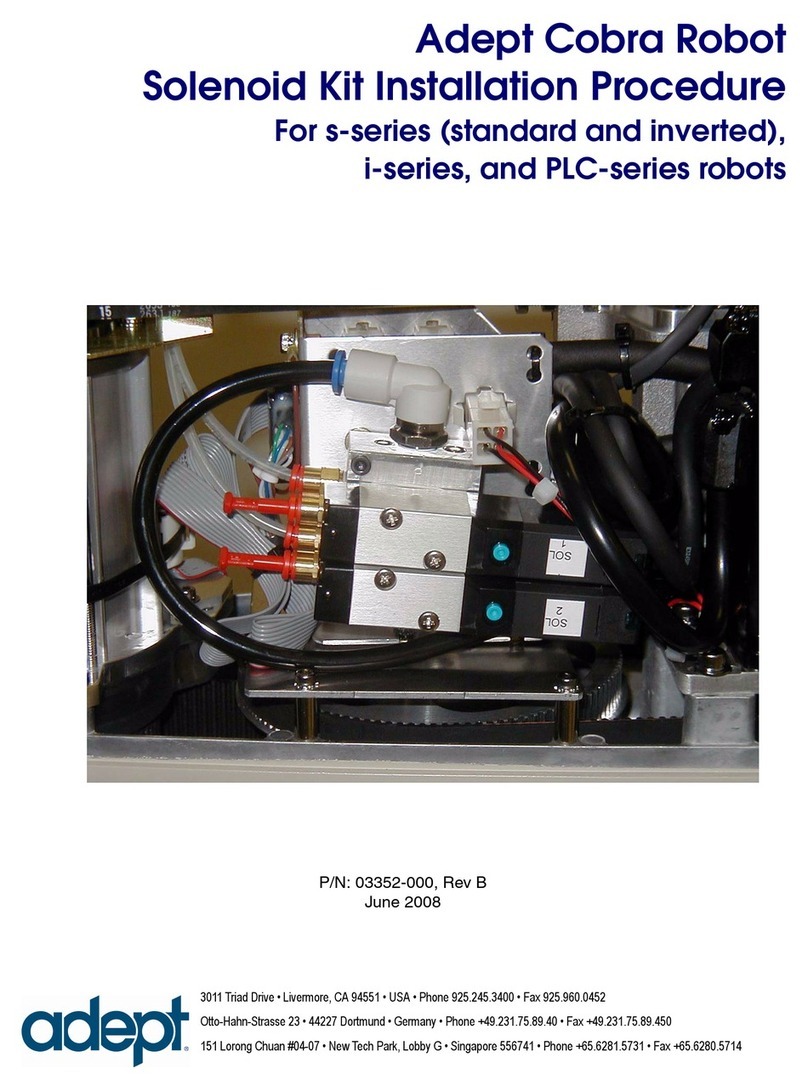
adept technology
adept technology Cobra 03352-000 Installation procedures
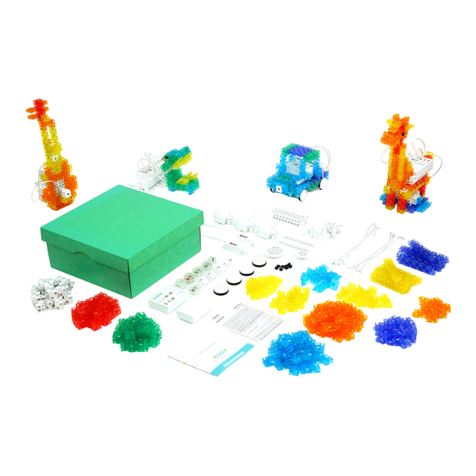
Sony
Sony KOOV EKV-250B Basic user's guide
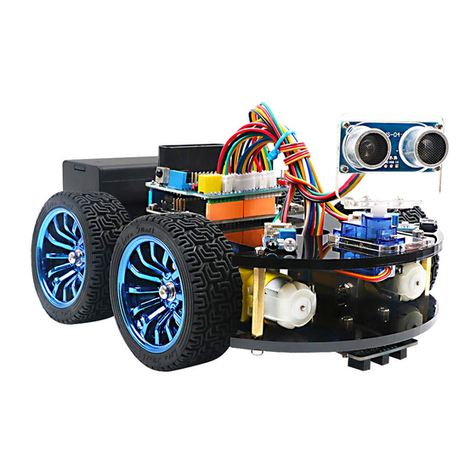
Keywish
Keywish Hummer-Bot instruction manual
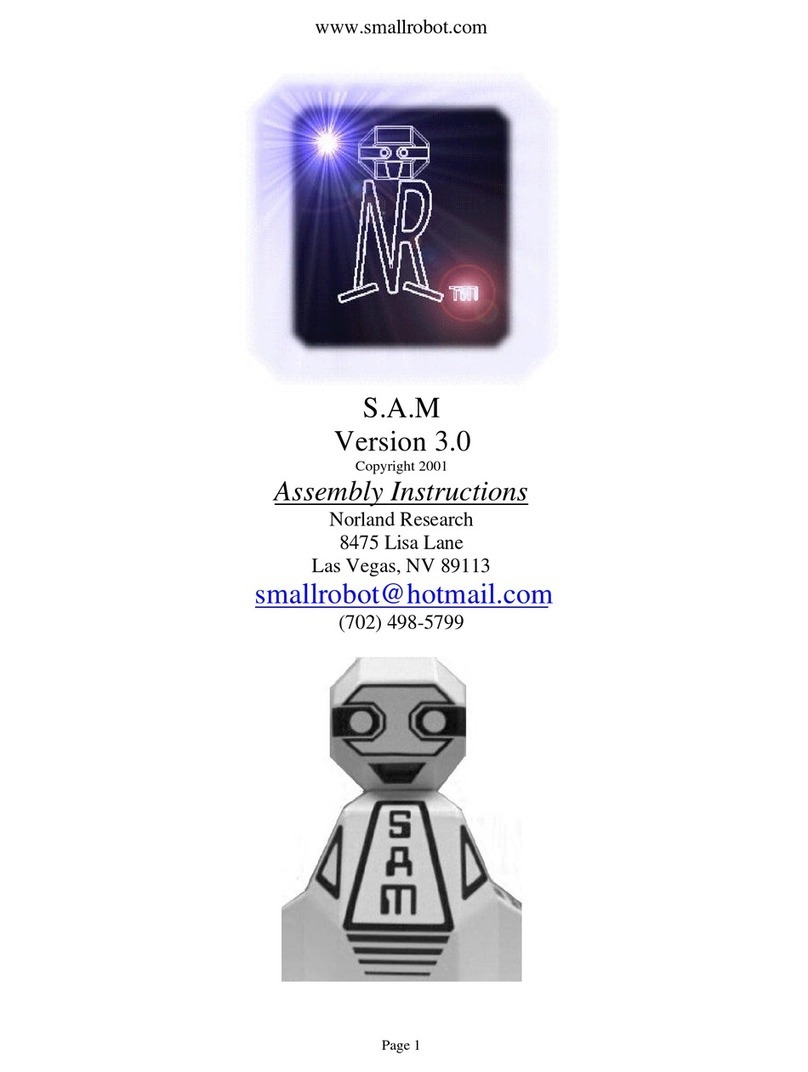
Norland Research
Norland Research S.A.M Version 3.0 Assembly instructions

